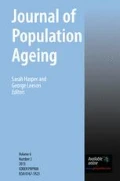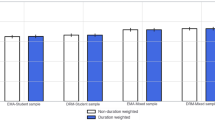Abstract
In 2009, a representative subsample of participants in the Health and Retirement Study (HRS: N = 5333; Age 50–101) responded to a short day reconstruction self-administered questionnaire that asked about their time and experiences on seven activities the previous day. We evaluate the quality and reliability of responses to this 10-min measure of experienced well-being and compare the properties and correlates of three intensity-based composites reflecting mixtures of activity-linked affective experiences (Activity-Positive Affect, Activity-Negative Affect, and Net Affect), and a frequency-based index, Activity Affective Complexity, that summarizes the proportion of activities that include a mixture of positive and negative affective experiences regardless of intensity. On average, older adults reported that 36 % of the activities in their day provided some mixture of feelings (e.g., interested and frustrated). Regression models revealed differential associations for the four constructs of affective well-being with socio-demographic factors, physical and mental health, and proximal indicators of the day’s context. We conclude that the HRS short day reconstruction measure is reliable and discuss the conceptual issues in assessing, summarizing, and interpreting the complexity of emotional experience in older adults.

Similar content being viewed by others
References
American Time Use Survey (ATUS) (2010). Well-being Module Questionnaire. U.S. Bureau of Labor Statistics and U.S. Census Bureau. Retrieved from http://www.bls.gov/tus/wbmquestionnaire.pdf.
Andrews, F. M., & Withey, S. B. (1976). Social indicators of well-being. New York: Plenum Press.
Belli, R. F., Stafford, F. P., & Alwin, D. F. (2009). Calendar and time diary: Methods in life course research. Thousand Oaks: Sage.
Bradburn, N. M. (1969). The structure of psychological well-being. Chicago: Aldine.
Bradburn, N. M., Rips, L. J., & Shevell, S. K. (1987). Answering autobiographical questions: the impact of memory and inferences on surveys. Science, 236, 157–161.
Cacioppo, J. T., & Berntson, G. G. (1994). Relation between attitudes and evaluative space: a critical review, with emphasis on the separability of positive and negative substrates. Psychological Bulletin, 115, 401–423.
Cacioppo, J. T., & Gardner, W. L. (1999). Emotion. Annual Review of Psychology, 50, 191–214.
Campbell, A., Converse, P. E., & Rodgers, W. L. (1976). The quality of American life: Perceptions, evaluations, and satisfactions. New York: Russell Sage.
Carlson, M. C., Parisi, J. M., Xia, J., Xue, Q.-L., Rebok, G. W., Bandeen-Roche, K., & Fried, L. P. (2012). Lifestyle activities and memory: variety may be the spice of life. The Women’s Health and Aging Study II. Journal of the International Neuropsychological Society, 18, 286–294.
Carstensen, L. L. (1993). Motivation for social contact across the life span: A theory of socioemotional selectivity. In J. E. Jacobs (Ed.), Nebraska symposium on motivation: 1992, developmental perspectives on motivation (Vol. 40, pp. 209–254). Lincoln: University of Nebraska Press.
Carstensen, L. L., Pasupathi, M., Mayr, U., & Nesselroade, J. R. (2000). Emotional experience in everyday life across the adult life span. Journal of Personality and Social Psychology, 79, 644–655.
Chida, Y., & Steptoe, A. (2008). Positive psychological well-being and mortality: a quantitative review of prospective observational studies. Psychosomatic Medicine, 70(7), 741–756.
Craik, F. I. M., & Rose, N. S. (2012). Memory encoding and aging: a neurocognitive perspective. Neuroscience & Biobehavioral Reviews, 36(7), 1729–1739.
Diener, E., & Chan, M. (2011). Happy people live longer: subjective well-being contributes to health and longevity. Applied Psychology: Health and Well-being, 3(1), 1–43.
Diener, E., & Tay, L. (2013). Review of the Day Reconstruction Method (DRM). Social Indicators Research, Published online 01 March 2013.
Diener, E., Sandvik, E., & Pavot, W. (2009). Happiness is the frequency, not the intensity, of positive versus negative affect. In E. Diener (Ed.), Assessing well-being: The collected works of Ed Diener (pp. 213–231). New York: Springer. Social Indicators Research Series Nr. 39.
Dockray, S., Grant, N., Stone, A. A., Kahneman, D., Wardle, J., & Steptoe, A. (2010). A comparison of affect ratings obtained with ecological momentary assessment and the day reconstruction method. Social Indicators Research, 99, 269–283.
Fratiglioni, L., Paillord-Borg, S., & Winblad, B. (2004). An active and socially integrated lifestyle in late life may protect against dementia. The Lancet: Neurology, 3, 343–353.
Fredrickson, B. L. (1998). What good are positive emotions? Review of General Psychology, 2, 300–319.
George, L. K. (2010). Still happy after all these years: research frontiers on subjective well-being in later life. Journal of Gerontology: Social Sciences, 65, 331–339.
Hamermesh, D. S. (2005). Routine. European Economic Review, 49, 29–53.
Hertzog, C., Kramer, A. F., Wilson, R. S., & Lindenberger, U. (2009). Enrichment effects on adult cognitive development. Psychology Science in the Public Interest, 9, 1–65.
Juster, F. T., Ono, H., & Stafford, F. P. (2003). An assessment of alternative measures of time use. Sociological Methodology, 33, 19–54.
Juster, F. T., & Stafford, F. P. (Eds.). (1985). Time, goods, and well-being. Ann Arbor: University of Michigan Survey Research Center.
Kahneman, D. (2011). Thinking fast and slow. New York: Farrar, Straus, and Giroux.
Kahneman, D., Krueger, A. B., Schkade, D. A., Schwarz, N., & Stone, A. A. (2004). A survey method for characterizing daily life experience: the day reconstruction method. Science, 306, 1776–1780.
Kahneman, D., Schkade, D. A., Fischler, C., Krueger, A. B., & Krilla, A. (2010). The structure of well-being in two cities: Life satisfaction and experienced happiness in Columbus, Ohio; and Rennes, France. In E. Diener, J. F. Helliwell, & D. Kahneman (Eds.), International differences in well-being. Oxford: Oxford University Press.
Katz, S., Ford, A. B., Moskowitz, A. W., Jackson, B. A., & Jaffe, M. W. (1963). Studies of illness in the aged. The index of ADL: A standardized measure of biological and psychosocial function. JAMA, 185, 914–919.
Krantz-Kent, R., & Stewart, J. (2007). How do older Americans spend their time. Monthly Labor Review, 130, 8–26.
Krueger, A. B., Kahneman, D., Schkade, D., Schwarz, N., & Stone, A. A. (2009a). National time accounting: The currency of life. In A. B. Krueger (Ed.), Measuring the subjective well-being of nations: National accounts of time use and well-being (Vol. Ch. 1, pp. 9–86). Chicago: Chicago University Press.
Krueger, A. B., Kahneman, D., Fischler, C., Schkade, D., Schwarz, N., & Stone, A. A. (2009b). Time use and subjective well-being in France and the U.S. Social Indicators Research, 93, 7–18.
Krueger, A. B., & Schkade, D. A. (2008). The reliability of subjective well-being measures. Journal of Public Economics, 92(8), 1833–1845.
Kuppens, P., Tuerlinckx, F., Russell, J. A., & Feldman Barrett, L. (2012) The relation between valence and arousal in subjective experience. Psychological Bulletin, Online First Publication, December 10, 2012. doi:10.1037/a0030811
Lachman, M. E., & Weaver, S. L. (1997). Midlife Development Inventory (MIDI) personality scales: Scale construction and scoring. Unpublished Technical Report. Brandeis University. (http://www.brandeis.edu/projects/lifespan/scales.html).
Larson, R., Zuzanek, J., & Mannell, R. (1985). Being alone versus being with people: disengagement in the daily experience of older adults. Journal of Gerontology, 40, 375–381.
Lawton, M. P., & Brody, E. M. (1969). Assessment of older people: self-maintaining and instrumental activities of daily living. Gerontologist, 9, 179–186.
Lindquist, K. A., & Barrett, L. F. (2008). Emotional complexity. In M. Lewis, J. M. Haviland-Jones, & L. F. Barrett (Eds.), Handbook of emotions (3rd ed., pp. 513–530). New York: The Guilford Press.
Loewenstein, G., O’Donoghue, T., & Rabin, M. (2005). Projection bias in predicting future utility. Quarterly Journal of Economics, 118, 1209–1248.
Maddala, G. S. (1983). Limited dependent and qualitative variables in econometrics. Cambridge: Cambridge University Press.
Miret, M., Caballero, F. F., Mathur, A., Naidoo, N., Kowal, P., Ayuso-Mateos, J. L., & Chatterji, S. (2012). Validation of a measure of subjective well-being: an abbreviated version of the Day Reconstruction Method. PLOS One, 7(8), e43887.
Moss, M. S., & Lawton, M. P. (1982). Time budgets of older people: a window on four lifestyles. Journal of Gerontology, 37, 115–123.
Nagi, S. Z. (1976). An epidemiology of disability among adults in the United States. The Milbank Memorial Fund quarterly. Health and Society, 439–467.
Powell, K. E., Paluch, A. E., & Blair, S. N. (2011). Physical activity for health: What kind? How much? How intense? On top of what? Annual Review of Public Health, 32, 349–365.
Pressman, S. D., & Cohen, S. (2005). Does positive affect influence health? Psychological Bulletin, 131, 925–971.
Robinson, J., & Godbey, G. (1997). Time for life: The surprising ways Americans use their time. University Park: The Pennsylvania State University.
Röcke, C., Li, S.-C., & Smith, J. (2009). Intraindividual variability in positive and negative affect over 45 days: do older adults fluctuate less than young adults? Psychology and Aging, 24, 863–878.
Rosow, I., & Breslau, N. (1966). A Guttman health scale for the aged. Journal of Gerontology, 21, 556–559.
Russell, J. A. (1980). A circumplex model of affect. Journal of Personality and Social Psychology, 39, 1161–1178.
Schimmack, U., & Diener, E. (1997). Affect intensity: separating intensity and frequency in repeatedly measured affect. Journal of Personality and Social Psychology, 73, 1313–1329.
Smith, J., Ryan, L.H., Becker, S., & Gonzalez, R. (2011). New survey measures of time use and experienced well-being for older adults. Retrieved from http://sites.isr.umich.edu/DNN/Portals/27/Docs/ROBUST%20Bulletin.pdf.
Smith, J., Fisher, G., Ryan, L., Clarke, P. House, J., & Weir, D. (2013). HRS Psychosocial and Lifestyle Questionnaire 2006–2010: Documentation Report. Retrieved from http://hrsonline.isr.umich.edu/sitedocs/userg/HRS2006–2010SAQdoc.pdf.
Steffick, D. E. (2000). Documentation of Affective Functioning Measures in the Health and Retirement Study. Retrieved from http://hrsonline.isr.umich.edu/sitedocs/userg/dr-005.pdf.
Stiglitz, J. E., Sen, A., & Fitoussi, J-P. (2009) Report by the Commission on the Measurement of Economic Performance and Social Progress [http://www.stiglitz-sen-fitoussi.fr/en/documents.htm].
Stone, A. A., Schwartz, J. E., Schwarz, N., Schkade, D., Krueger, A., & Kahneman, D. (2006). A population approach to the study of emotion: diurnal rhythms of a working day examined with the Day Reconstruction Method (DRM). Emotion, 6, 139–149.
Stone, A. A., Schwartz, J. E., Broderick, J. E., & Deaton, A. (2010). A snapshot of the age distribution of psychological well-being in the United States. Proceedings of the National Academy of Sciences USA, 107(22), 9985–9990.
Tan, L., Chan, D., & Diener, E. (2013). The metrics of societal happiness. Social Indicators Research, (published, online June 6, 2013).
Tourangeau, R., Rips, L. J., & Rasinski, K. (2000). The psychology of survey response. New York: Cambridge University Press.
Ver Ploeg, M., Altonji, J., Bradburn, N., DaVanzo, J., Nordhaus, W., & Samaniego, F. (Eds.). (2000). Time-use measurement and research: Report of a workshop. Washington DC: National Academy Press.
Waidmann, T., & Freeman, V. (2006). The daily activities of the community-dwelling elderly: Evidence from the American time use survey. United States Department of Health and Human Services: Office of disability, aging and long-term care policy.
Watson, D., & Clark, L. A. (1992). Affects separable and inseparable: on the hierarchical arrangement of negative affect. Journal of Personality and Social Psychology, 62, 489–505.
Watson, D., & Clark, L. A. (1994). The PANAS-X: Manual for the Positive and Negative Affect Schedule—Expanded Form. Unpublished manuscript. University of Iowa, Iowa City. Retrieved from http://www.midss.org/content/panas-x-manual-positive-and-negative-affect-schedule.
Watson, D., & Clark, L. A. (1997). Measurement and mismeasurement of mood: recurrent and emergent issues. Journal of Personality Assessment, 68, 267–296.
Watson, D., Wiese, D., Vaidya, J., & Tellegen, A. (1999). The two general activation systems of affect: structural findings, evolutionary considerations, and psychobiological evidence. Journal of Personality and Social Psychology, 76, 820–838.
Wilson, R. S., & Bennett, D. A. (2003). Cognitive activity and risk of Alzheimer’s disease. Current Directions in Psychological Science, 12, 87–91.
Wilson, T. D., & Gilbert, D. T. (2005). Affective forecasting: knowing what to want. Current Directions in Psychological Science, 14, 131–134.
Acknowledgments
This work was supported by funding from the National Institute of Aging at the National Institutes of Health (grant number R01 AG040635). The HRS (Health and Retirement Study) is sponsored by the National Institute on Aging (grant number NIA U01AG009740) and is conducted by the University of Michigan.
Author information
Authors and Affiliations
Corresponding author
Rights and permissions
About this article
Cite this article
Smith, J., Ryan, L.H., Queen, T.L. et al. Snapshots of Mixtures of Affective Experiences in a Day: Findings from the Health and Retirement Study. Population Ageing 7, 55–79 (2014). https://doi.org/10.1007/s12062-014-9093-8
Received:
Accepted:
Published:
Issue Date:
DOI: https://doi.org/10.1007/s12062-014-9093-8




